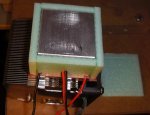- Joined
- Mar 9, 2011
- Messages
- 3
- Points
- 0
Hmmmm... Can we use a TEC to more accuratly move the heat from the diode to external fins? I am again... just looking at how my cpu cooler worked  It had "pipelines" that lifted off the cpu into a huge "fin block" that was cooled by a fan.
It had "pipelines" that lifted off the cpu into a huge "fin block" that was cooled by a fan.
P.S. (i know it doesnt get rid of the heat .. why I asked how we can cool the hot side of the plate)
.. why I asked how we can cool the hot side of the plate)
Has anyone ever made a water cooled block haha? Running a line from the heat sink to the outside of the unit and back would lose quite a bit of heat ... who knows how small of a pump we could find tho lol
... who knows how small of a pump we could find tho lol
HAHAHAHA (http://www.xavitech.com/?gclid=CNiqtc-fwqcCFcW5KgodQ1RTJg) TINY water pump
P.S.S What if we had a simply circut that would turn the TEC on for 30 seconds, off 30 seconds, on 30 seconds.... blah blah blah?
P.S. (i know it doesnt get rid of the heat
Has anyone ever made a water cooled block haha? Running a line from the heat sink to the outside of the unit and back would lose quite a bit of heat
HAHAHAHA (http://www.xavitech.com/?gclid=CNiqtc-fwqcCFcW5KgodQ1RTJg) TINY water pump
P.S.S What if we had a simply circut that would turn the TEC on for 30 seconds, off 30 seconds, on 30 seconds.... blah blah blah?
Last edited:







